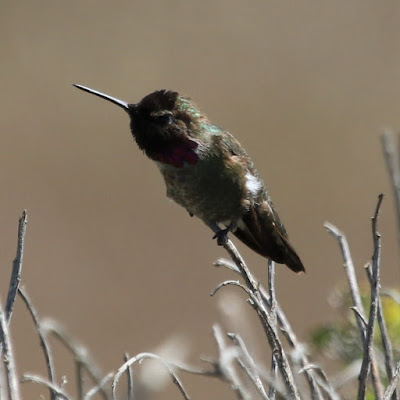Saturday 2 April 2023
 |
| Marbled Godwit - Moss Landing CA |
After watching the Sea Otters at Moss Landing on California's Monterey Bay (see previous blog here), we followed a trail along the Salinas River, bounded on one side by a salt marsh and the other by the back of the dunes – part of the Salinas River State Beach. American Coot and American Avocet were visible in the distance. A short walk through the dunes took us onto the beach itself, some of which had been roped off to protect nesting birds – probably Snowy Plovers – although none were visible. A single Whimbrel flew past followed by a Marbled Godwit, while a few Surf Scoters (record photo below) battled (appropriately enough) through the surf. The wind had picked up; the ocean was looking choppy and the beach had no shelter, so we didn’t linger.
%20Moss%20Landing%20CA%202.4.23.JPG) |
| Surf Scoter (record photo) - Moss Landing CA |
Back by the creek, in the shelter of the dunes, a Red-tailed Hawk (below) flew into the only nearby tree and I was able to snatch some photos before it moved quickly on. This is the common roadside hawk of most of North America (west and east).
 |
| Red-tailed Hawk - Moss Landing CA |
The trail next to the creek produced a few birds that will be very familiar to West Coast residents, but are more exciting to the visiting birder.
 |
| White-crowned Sparrow - Moss Landing CA |
White-crowned Sparrow (above) is migratory across much of North America, but resident on the Californian coast and also some inland areas of the west, like Utah. This is an example of the Pacific population (subspecies nuttalli – one of five), which has a grey (not white) eye stripe and a yellow (not orange) bill.
 |
| House Finch - Moss Landing CA |
House Finch (above) is common and widespread across the US and Mexico, but some thought is needed to distinguish it from Purple Finch (also possible on this coast) and Cassin’s Finch, which is a species of western pine forests. The key ID feature for this male is the combination of the red head (brightest on the forehead) and striped flanks.
 |
| Anna's Hummingbird - Moss Landing CA |
%20Moss%20Landing%20CA%202.4.23.jpg) |
| Anna's Hummingbird (showing gorget) - Moss Landing CA |
Hummingbirds can be tricky: the iridescent throat feathers (gorget) on this male Anna’s Hummingbird (above) varied in colour from red to purple depending on the light. But they are not flared enough for Costa’s Hummingbird, which is the main confusion species here. Anna’s is common and resident on the Pacific coast, and non-migratory.
By now it was coffee time, so we walked back into Moss Landing in search of a café. A busy restaurant directed us to an excellent roadside coffee shop - The Power Plant, named for the looming power station nearby. Revived, we drove up to Jetty Road and parked for a quick birdwatch over the adjoining mudflats. This quickly produced the Marbled Godwit pictured at the start of the blog post, which came very close. It’s the ‘default’ West Coast godwit species. Sibley shows it as wintering on the Pacific coast, but eBird shows that they are seen at Moss Landing all year round. The species breeds in the centre of North America, an area including southern Canada and the northern mid-West US states. In flight, the undersides of their wings are a rufous colour.
Picking its way along the shoreline was a Greater Yellowlegs (below).
 |
| Greater Yellowlegs - Moss Landing CA |
Separating Greater and Lesser Yellowlegs is one of the great US birding challenges. Obviously, size is a factor – and this looked like a large bird – but with reference to Sibley the key features suggesting Greater here are (1) the relatively long bill and (2) the obvious dark bars on the flanks. The second of these is only helpful to separate birds in breeding plumage. (But do let me know if I've got this one wrong!) Also here were a Grey Plover (called Black-bellied Plover here), a Black-winged Stilt and two Sanderlings, as well as both Scaup species, Goldeneye and Red-breasted Merganser.
 |
| Western Sandpiper (record photo) - Moss Landing CA |
The mudflats on the other side of the road were dotted with small waders, including this Western Sandpiper (above - a poor record photo), one of at least twenty. Dumpy little things, these have black legs (distinguishing them from Least Sandpiper – green/yellow) and (in breeding plumage) rufous head and cheek patches, with a heavily streaked breast. They are found on both US coasts, but breed in Alaska and eastern Siberia.
We drove on down Jetty Road, crossing sand that had drifted over the tarmac. Parking by the roadside we got a view across the sandbank to a group of snoozing Harbour Seals (below).
 |
| Harbour Seals - Moss Landing CA |
This is the same species as the UK's Common Seal, which has a massive worldwide range across the northern hemisphere. Their hindflippers, relatively small and trailing, differ from those of the sealions.
Not far away was a group of gulls that I looked at with great interest – the ‘scope was helpful here. This is a well-known gull roost area, with California Gulls regularly present. Happily, they were here now (two are pictured below). California Gulls are very like Herring Gulls (possible here), but smaller; the main ID features are the greenish-yellow legs, dark iris and both red and black markings on the bill.
%20FFO%20Moss%20Landing%202.4.23.JPG) |
| California Gull (detail) - Moss Landing CA |
With that, it was time to move on from Moss Landing ... but not too far. Next stop was the excellent Elkhorn Slough reserve, a short drive away.
To be continued ...
Reference
Sibley, D. (2003) Field Guide to the Birds of Western North America. London: Christopher Helm.


No comments:
Post a Comment